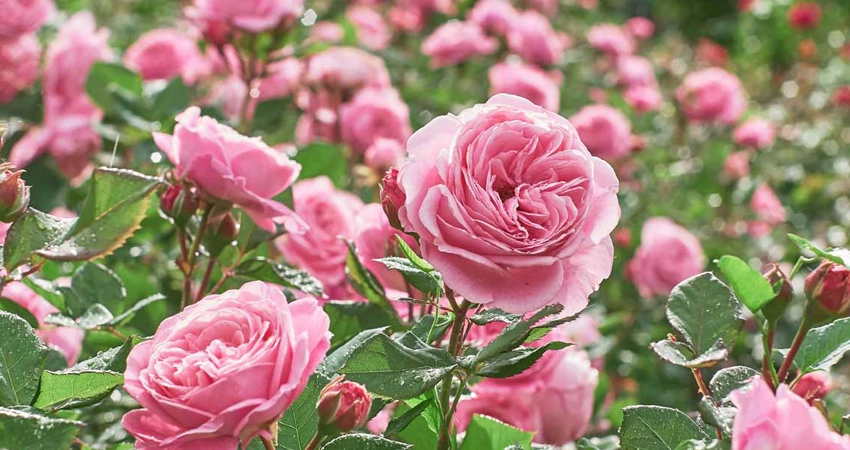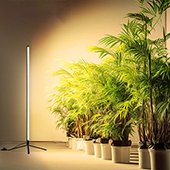
Menu
Are you getting into indoor gardening and feeling overwhelmed by all the acronyms like PAR, PPF, PPFD, and PPE?
The question on everyone’s mind remains: what are the meanings of these terms in the world of LED grow lights? Why are they important?
Don’t worry. We are here to help simplify things for you! Understanding these terminologies is the key to making informed decisions when selecting grow lights.
Before defining technical terms, let me explain lumens and PAR. Some customers often mistake plant lights for regular ones.
We use lumens as a unit of measurement to judge the brightness of traditional lighting, which is helpful for yellow/green/orange spectrum light perceived by human eyes.
For planting grow lights, the lumens won’t give you the information you need. Brightness, as perceived by our eyes, isn’t a reliable indicator for providing the right light to plants. This is because plants don’t “see” light we do.
That’s why lumens are not used to measure LED grow lights. Instead, the plant lighting industry focuses on PAR, which stands for Photosynthetically Active Radiation. Plants primarily use the blue and red spectrum for growth, despite human eye sensitivity to green, yellow, and orange.
In summary, plants don’t just need high-lumen output; they need a lot of light within the PAR range.
PAR refers to the effective spectrum of light used by plants for photosynthesis. It covers the visible light spectrum from 400 to 700 nanometers. Spectrally, this includes all wavelengths from blue to red.
It’s especially crucial for the growth and development of plants as it provides the light energy necessary for photosynthesis.
PAR meters are typically used to measure how much PAR light a lamp emits. This measurement is represented by identifying the number of photons emitted within the PAR range.

When light falls on plant leaves, chlorophyll, and other pigments absorb photons and convert them into chemical energy, exciting electrons in chlorophyll and initiating photosynthesis.
Photosynthesis uses light energy to convert carbon dioxide and water into glucose and oxygen while releasing oxygen. Plants utilize the glucose produced as a source of power and growth.
Plants convert light energy within PAR into biochemical energy through photosynthesis, sustaining their growth and survival.
PPF measures the total amount of PAR emitted by a light source per second. The optimal measure of how much PAR light a fixture can produce is called PPF.
It is measured in micromoles per second (μmol/s) and provides a way to assess the total amount of light energy emitted by a lighting source, regardless of the light’s direction.
It comprehensively evaluates the lighting system’s ability to provide photons for plant growth and photosynthesis. This metric is crucial when assessing the overall capability of a light source in supporting indoor plant growth and development.

PPF represents the total number of photons emitted by a light source that is utilized in photosynthesis by plants. It is crucial for plant growth and development.
Plants use PAR for photosynthesis, converting light energy into biochemical energy. A higher PPF is crucial for encouraging plant growth, flowering, and fruit development, particularly in indoor environments where light energy is limited.
The PAR output from LED grow lights holds significant importance, and now you may have a better understanding of its value. Do you know how much light reaches your plants via PAR output from LED grow lights?
PPFD measures the amount of PAR reaching a given area, indicating the intensity of light hitting every part of the canopy. This is a crucial matter for growers because it explains how light impacts plants.
Its unit is μmol/m2/s, representing the PPF within one square meter, that is, the number of PAR photons landing on the crop surface per second.

Changes in distance affect PAR light intensity measured from the light source to the plant surface due to the inverse square law. In simpler terms, the intensity rapidly decreases as the distance between the light source and the plant surface increases.
Let me clarify this with an example. Suppose you measure the intensity of PAR light when the measuring device is held at a distance of one inch from the light source, and you get a reading. Now, if you take another readout by moving the measuring device one foot away from the light source, you will notice that the number you get is significantly lower than the previous one.
This happens because the intensity of the light decreases as the distance between the light source and the measuring device increases.
Merely knowing the PAR light output of a grow light is inadequate. It is essential to comprehend the amount of PAR light that reaches the plant’s actual growth area.
In general, each plant has specific PPFD requirements to achieve optimal yields. For instance, in conventional cannabis cultivation, the PPFD during the seedling stage is around 100-300 μmol/m2/s, during the vegetative is 400-600 μmol/m2/s, and during the flowering is 800-1,000 μmol/m2/s.
It’s important to note that measuring PPFD two feet above the canopy in a tent will be vastly different from measuring it in a warehouse with a 20-foot ceiling.
Match the PPFD and footprint of your LED grow lights to your specific canopy, as most fixtures are designed for hanging heights and coverage areas. It’s crucial to buy the right light for your space since too much or too little light can be detrimental.
PPE is a crucial indicator quantifying the efficiency of lighting fixtures, representing the statistical data of how much PAR light an LED plant grow light produces from its input power.
It is measured in micromoles per joule (μmol/J), reflecting the number of photons emitted per unit of energy input.
The higher the value, the more efficient the lighting system is in converting electrical energy into light usable by plants, providing more effective and energy-efficient illumination for photosynthesis and plant growth.
LED suppliers usually provide efficiency ratings for their products, which indicate the amount of light output per unit of energy input.
If you only know the PPF value and the wattage of a light fixture, you can calculate the light efficiency by dividing the PPF by the wattage. PPE = PPF/ wattage.
A light fixture with a PPF value of 800 and a power of 400W has a light efficiency of 2.0. This means a light fixture with an efficiency of 2.0 µmol/J and a 400W grow light can produce a PPF of 800 µmol.
HPS lights used to have the highest efficacy ratings, reaching up to 1.9 µmol/J, which is why they were famous for achieving good yields. However, LED lights have surpassed HPS by far, reaching up to 3.0 µmol/J in efficacy. As HPS efficiency remains constant, LED efficiency is expected to continue improving.
If you’re still having trouble understanding, please refer to Dr. Bruce Bugbee’s explanation of the differences between all the definitions.
When choosing LED grow lights, it is important to consider the quality of the spectrum. Plants rely heavily on blue and red spectrums more than any other colors in the spectrum. If your grow light emits a substantial amount of green light, it means that the plant is not utilizing the full spectrum. Photosynthetic efficiency is much higher in the red or blue regions of the spectrum.
Most importantly, don’t hesitate to ask for assistance when selecting the right lighting system for your crops. We’re here to support motivated growers.
From custom light planning, to tailored quotes, and everything in between, our team of horticulture experts are always ready to assist.
We are a professional LED plant light manufacturer, committed to using technology to enhance the maximum potential of the lamp, continuously maximizing the benefits for growers, and saving energy for the planet.



